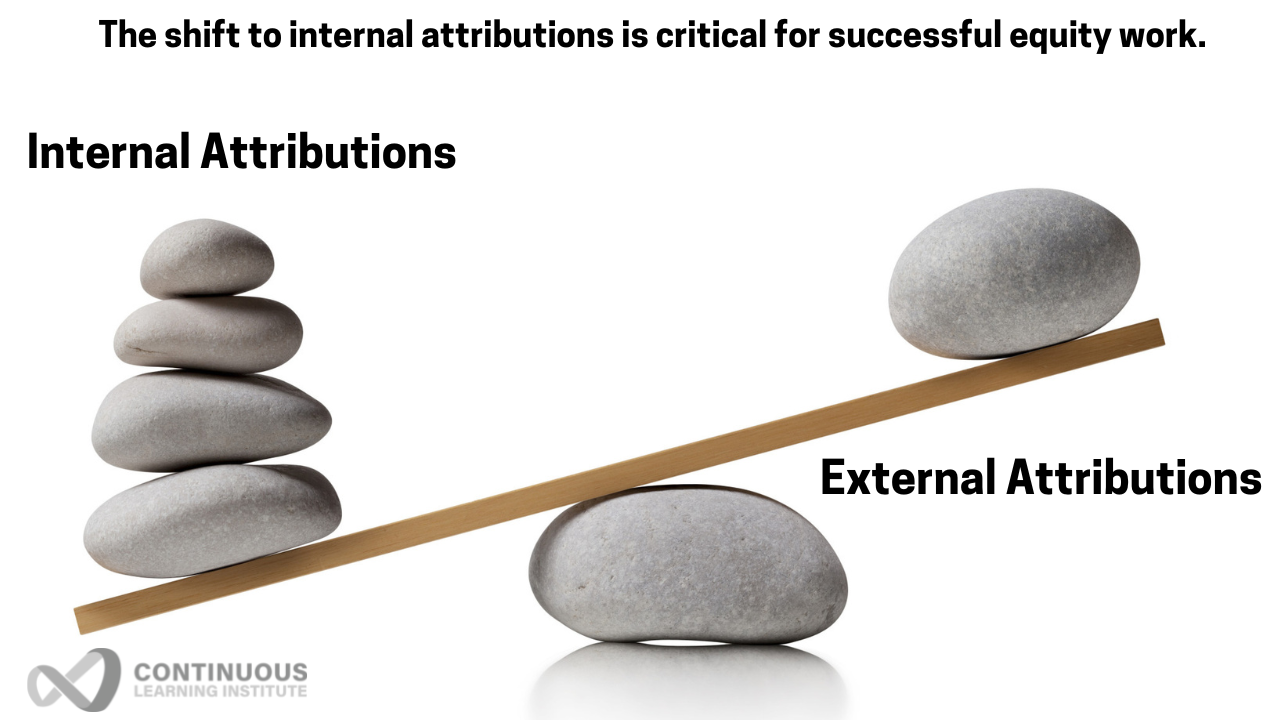Foundational Ingredient For Successful Equity Work

The ability of faculty and educators in general to change—from external to internal attributions—is a foundational ingredient in student success, particularly for Latina/o/x students. External attributions assign blame for something that is beyond a faculty's control. The primary factor that faculty have control over is their internal attributions--the ability to consistently improve their craft.
Let's consider a longitudinal study conducted by my colleagues Dr. Bill Saunders of UCLA and Dr. Claude Goldenberg of Stanford, guided by their mentor, UCLA Professor Emeritus Dr. Ron Gallimore.[1] In their study of meaningful teacher collaboration with a focus on improving instruction, there was a 41% gain in student achievement above and beyond the control group, and a 54% gain for Latina/o/x students. Why did Latina/o/x students outperform other students by 13 points in a 5-year comparison study?
The external evaluator asked the teachers in the collaborative group and the control group the same question:
"To what extent do you attribute student outcomes, positive or negative?"
Teachers from the control group focused on external factors. For example, the parents don't speak English, students are not academically prepared, etc.
When the evaluator asked the collaborative group the same question, the teachers focused on their instruction.[2]
The control group, in short, concentrated on external attributions. The collaborative group prioritized internal attributions. We could hypothesize that Latino/a/x students benefitted greatly when teachers refrained from assigning blame to students and other external factors. Latina/o/x students flourished in classrooms where teachers were committed to constantly improving their craft.
That said, regardless of whether it takes place in K-12 or higher education, teaching is teaching. Teachers need support to learn from one another. The attribution change is foundational for faculty to switch from equity yellow (educators who are lukewarm about racial equity) to green lighters (educators who embrace and enact racial equity). And occasionally move the red lighters (anti-racial equity educators). But here's the thing: According to some university equity professors and independent professional development providers (who have a significant influence on many community college and open access faculty), scolding white faculty about their white supremacy in meetings and/or professional development sessions is the most effective and productive approach for changing faculty attributions. I'm fully aware that white fragility, privilege, and supremacy exists.
The questions is: Does this approach lead equity yellow lighter faculty to switch to green lighters? Does this approach change their mindset? It's clear from my experience working as an embedded coach for many years at a variety of institutions (I also coached in K12) and from the frustrations directors and deans of equity have conveyed to me that the answer is a resounding no. To placate, some equity yellow lighters may give the impression that they have turned green through their words, but their actions speak otherwise. They still won't change their practices.
Research suggests, and as an unabashed hard core implementor (I don't reside in theory & philosophy land; I'm all about helping colleges and faculty get shit done), we know that it's important to soften the ground for equity work by getting white faculty (and sadly, some Latinos) to realize that they need to own their practices first. Once they make the shift, wonderful equitable work of all kinds starts to flourish.
For example, learn about how a collaborative group of Santa Barbara City College English faculty work to continually improve their craft toward more equitable outcomes. Also learn about how Citrus College math faculty and their community of practice improved outcomes for D.I. populations by focusing on internal attributions. Innovation and improved pedagogy has produced dramatic improvements in student of color outcomes.
As you continue the hard work of equity, ask yourself: Is our institution’s approach genuinely moving equity yellow lighter faculty to become green lighters? Are red lighters moving at all? If the hammer approach is working, continue to move full steam ahead! If not, perhaps it's time to rethink that a hammer is not the most productive approach when what you really need is a screwdriver.
Be passionate. But be practical. The approach matters. A shift in faculty attributions is foundational. How will you help to create the conditions for this critical shift? Will you create a culture of organizational learning or of organizational shaming?
***
Also visit: Transformational Change: Challenges & Opportunities | The "In Between": What's Needed to Improve Student Outcomes
[1] Saunders, W., Goldenberg, C., & Gallimore, R. (2009). Increasing achievement by focusing grade level teams on improving classroom learning: A prospective, quasi-experimental study of Title 1 schools. American Educational Research Journal, 46 (4), 1006-1033.
[2] McDougall, D., Saunders, W. & Goldenberg, C. (2007). Inside the black box of school reform: Explaining the how and why of change at Getting Results schools. Journal of Disability, Development, and Education, 54, 51-89.






